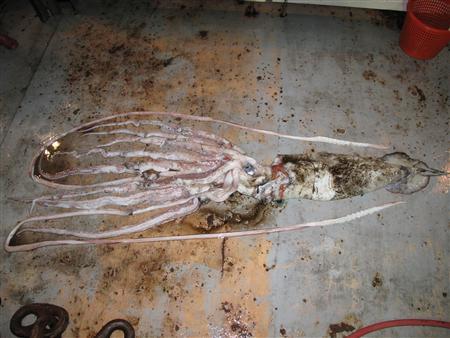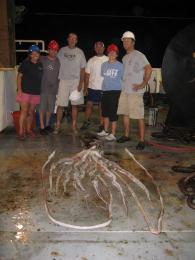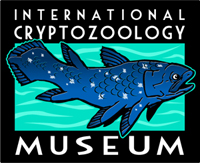Gulf of Mexico Gives Up Giant Squid
Posted by: Loren Coleman on September 23rd, 2009
American scientists in the Gulf of Mexico unexpectedly netted a 19.5-foot (5.9-meter) giant squid off the coast of Louisiana, demonstrating how little is known about life in the deep waters of the Gulf.
Not since 1954, when an Architeuthis was found floating dead off the Mississippi Delta, has the rare species been spotted in the Gulf of Mexico.
The squid, weighing 103 pounds (46.7 kg), was caught July 30 (but was only announced this week). It was recovered in a trawl net more than 1,500 feet underwater, being pulled by a research vessel.
The specimen was sent to the Smithsonian Institution’s National Museum of Natural History for further study, now one of only five from the USA in the collection.
“As the trawl net rose out of the water, I could see that we had something big in there … really big,” Anthony Martinez, a marine mammal scientist for the National Oceanic and Atmospheric Administration and the chief scientist on the sperm whale research cruise, observed.
This find illustrates how little we know about what is swimming around in the deep waters of the Gulf of Mexico. This is the first time one has actually been captured during scientific research in the Gulf of Mexico.
Michael Vecchione, director of
NOAA’s Fisheries Service’s National
Systematics Laboratory
London’s Telegraph (22 Sept 2009) had one of the more bizarre comparative remarks about the find: “The squid was more than two feet longer than the 2010 Ford Crown Victoria taxi edition.”
For more background on giant squids in general, see here.
No life-size models of Architeuthis in the collection (yet), but you’ll be able to see full-size replicas of a coelacanth, an immature Cadborosaurus, a Sasquatch, a FeeJee mermaid, and some forthcoming surprises! Join hundreds of other members of the cryptozoology community in supporting the International Cryptozoology Museum as it opens in downtown Portland, Maine.
Please click on the button below (not the one up top) to take you to PayPal to send in your museum donation.
If you wish to send in your donation via the mails, by way of an international money order or, for the USA, via a check (made out to “International Cryptozoology Museum”) or money order, please use this snail mail address:
Loren Coleman, Director
International Cryptozoology Museum
PO Box 360
Portland, ME 04112
Thank you, and come visit the museum at 661 Congress Street, Portland, Maine 04101, beginning November 1, 2009!! This educational/scientific/natural history museum is not a 501(c)3.
About Loren Coleman
Loren Coleman is one of the world’s leading cryptozoologists, some say “the” leading living cryptozoologist. Certainly, he is acknowledged as the current living American researcher and writer who has most popularized cryptozoology in the late 20th and early 21st centuries.
Starting his fieldwork and investigations in 1960, after traveling and trekking extensively in pursuit of cryptozoological mysteries, Coleman began writing to share his experiences in 1969. An honorary member of Ivan T. Sanderson’s Society for the Investigation of the Unexplained in the 1970s, Coleman has been bestowed with similar honorary memberships of the North Idaho College Cryptozoology Club in 1983, and in subsequent years, that of the British Columbia Scientific Cryptozoology Club, CryptoSafari International, and other international organizations. He was also a Life Member and Benefactor of the International Society of Cryptozoology (now-defunct).
Loren Coleman’s daily blog, as a member of the Cryptomundo Team, served as an ongoing avenue of communication for the ever-growing body of cryptozoo news from 2005 through 2013. He returned as an infrequent contributor beginning Halloween week of 2015.
Coleman is the founder in 2003, and current director of the International Cryptozoology Museum in Portland, Maine.













I love the chance to see something like this. While we know these monsters exist we have very little knowledge of their habits and lifestyle. Any research we can do will surely benefit all peoples in understanding this marvelous creature. Can you imagine being the target of a 19 ft Squid, you would have the chances of a snowball in July of surviving. It is truly lucky for us that they live so deep in the ocean, or we would have something to truly fearl lurking in the coastal waters.
Hopefully one day we’ll have one of these babies exposed at the museum, Loren 🙂
Great discovery. Vecchione is totally right. We don’t know diddly.
Magnificent specimen indeed. Visions of Captain Nemo and Jules Verne pop up as I look at the pictures. Hopefully (although admittedly highly unlikely) one of these Titans of the Deep Sea will be captured alive and put in an Aquarium.
Very interesting. It lends credence to the old stories. As to their only living down deep, I wonder if they might not have come to the surface more frequently back before the commercial harvesting of pelagic fishstocks had reduced the vast schools of fish and other potential prey that likewise used to be seen at the surface down to the faint echo of their historical accounts…When it was alive and its tissues were filled with its pressurized bodily fluid, and controlling it chromatophores, acting with a deliberate behavior indicating it was strategizing it’s next mover… it must have really been a thing of awesome beauty…and really, do we actually know enough about them to think this was the biggest one and that they get no larger?
I once came upon the body, carpace?, fuselage? ah..mantle (that’s the word..here’s the wiki) of a large and recently expired squid along a beach near Icy Straits in Southeast Alaska, and I presumed it was a Humboldt since the they are reported in the north when the currents are just so, about 3 feet long. It’s head and tentacles were gone but the body was still kind of semi-rigid (carteliginous?) and the markings of reddish brown on pearly grayish silver (like calamari) were still quite impressive. Kinda funny but you see some pretty impressive stuff on really wild beaches. I wonder if people sometimes fail to appreciate that just a few thousand feet away, down at out at about 45 degrees, if you live where there’s not much coastal plain like along western North America, there is a world still pretty rich with exotic life and we only see the occasional dead thing that happens to not sink or get eaten right away. I’ve heard they’re kinda rich in ammonia which is an adaptation for cold water and high pressures.
Tide’s out, table’s set…for somebody somewhere.
I’m not surprised that giant squid could keep popping up where they may not be expected. We really do not know much about the distribution of these creatures at all. We can only use where dead ones are found and the rare live one, as a reference. We have a good idea of what sorts of conditions they favor, but other than that, it would be premature to say that giant squid, or colossal squid, couldn’t be found in a given place. I think we are going to find that these magnificent creatures are found in more areas than we now realize.
Dogu4- As much as I would like to imagine giant squid hunting at the surface for pelagic fish, there are certain physiological restrictions involved. It has been suggested in some studies that the circulatory system and oxygen carrying capacity of giant squid blood is not very efficient at warmer, surface waters. Thus, a giant squid at the surface faces the very real possibility of suffocating if it can’t get down to deeper water. At the surface, it is vulnerable and probably not in the best of health.
Many times, the giant squid seen near the surface are not likely there to hunt. It is thought that they could be brought to the surface by warm water currents and if they are unable to get back down to the depths again, they will perish. Some giant squid carcasses have turned up in areas where cold and warm water currents clash, which lends this idea credence. Then there are the ones that were physically dragged up by whales. Either way, it is not their natural habitat. The physiology of giant squid just doesn’t seem to be made for routinely hunting in surface waters.
Ah the wild beaches. I too have come across some very odd things on secluded beaches in my time. And this is just a fraction of what is out there. In the case of deep dwelling, mysterious creatures like the giant squid, it is often all we have to go on. I really does make one wonder what lies down in the abyss right off shore.
I predict that, as the oceans get warmer due to iceberg melting, that we will see more of these deep-sea critters popping out in the news.
Hmm… that’s a good idea for a Horror flick a-la Piranha! 🙂
amazing news, its incredible how little is actually known of the range of the animal (or subspecies?)
this report actually came to us the day we were installing our giant squid for ArtPrize, an international art competition in Grand Rapids, Michigan. pretty appropriate timing: Freeman & Perec’s ‘Sixty Foot Ghost‘.